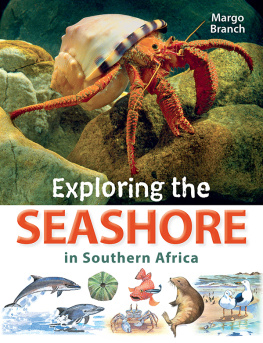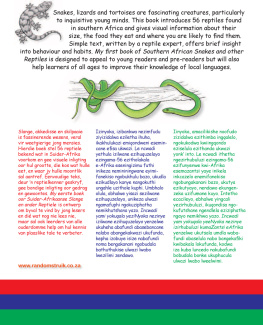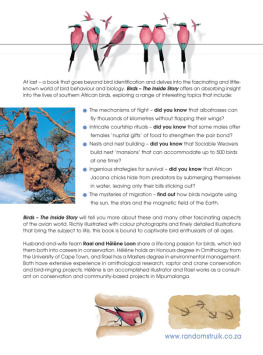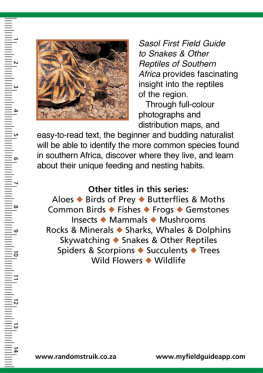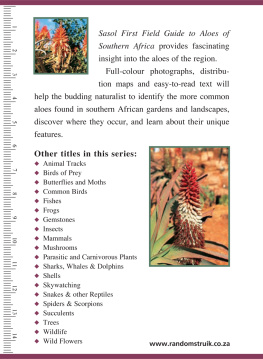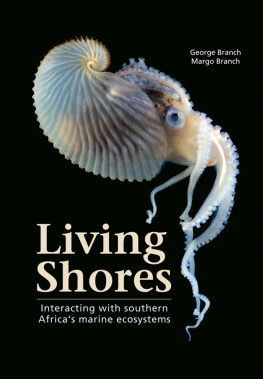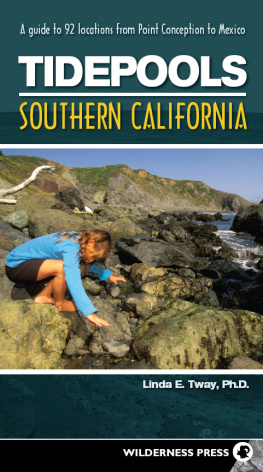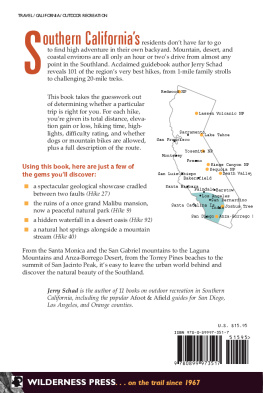
Published by Struik Nature
(an imprint of Penguin Random House South Africa (Pty) Ltd)
Reg. No. 1953/000441/07
The Estuaries No. 4, Oxbow Crescent (off Century Avenue), Century City, 7441, South Africa
PO Box 1144, Cape Town, 8000 South Africa
Visit www.penguinrandomhouse.co.za and join the Struik Nature Club for updates, news, events and special offers.
First published in in 1987 by Struik Publishers
Second edition published in 1998 by Cambridge University Press
Third edition published in 2018 by Struik Nature
Copyright in text, 1987, 1999, 2018: Margo Branch
Copyright in photographs, 1987, 1999, 2018: George Branch
Copyright in illustrations, 1987, 1999, 2018: Margo Branch
Copyright in published edition, 2018: Penguin Random House South Africa (Pty) Ltd
Publisher: Pippa Parker
Managing editor: Helen de Villiers
Editor: Emily Donaldson
Designers: Janice Evans, Neil Bester
Illustrator: Margo Branch
Proofreader: Thea Grobbelaar
All rights reserved. No part of this publication may be reproduced, stored in a retrieval system, or transmitted, in any form or by any means, electronic, mechanical, photocopying, recording or otherwise, without the prior written permission of the copyright owner(s).
Print ISBN: 9781775846277
ePub ISBN: 9781775846284
Acknowledgements
What fun we have had over the years unpacking the wonders of our shoreline with friends and our expanded family Bryony, Adriaan, Trevor, Ruth, Simon, Patrick, Sam and Miya. We have shared field trips with students and researchers from the coastal universities of Cape Town, KwaZulu-Natal, Rhodes and Nelson Mandela Bay. The staff and volunteer rangers of the South African National Parks and the inspiring members of MCEN (Marine and Coastal Educators Network) have all contributed. My 10 years working at Two Oceans Aquarium in Cape Town provided many opportunities to learn, observe, paint and photograph the underwater world. At Arniston, the late Bertie Jessop taught me the joys of watercolour painting and exploring. A big thank you to the team at Struik Nature and especially Janice Evans who, in 1987, designed the first edition and who has also provided the concept for this fresh new edition.
Contents
Introduction
Many living treasures occur along southern Africas coastline. Some float or swim in the sea; others dig themselves into the sand or cling to the rocks. Our shores are bathed by two oceans the warm Indian Ocean to the east, with its many bright tropical animals, and the cold Atlantic Ocean to the west, with its vast kelp forests and huge shoals of silver fish. Rich and fascinating life occurs wherever the land meets the sea, because the constantly changing tides, currents, wind, waves and sunlight create many different habitats.
Lets dive in now and peer through our goggles at the magical life beneath these waters, then lift our eyes and watch dolphins leaping and seagulls soaring or maybe even a whale blowing! All of these living things depend on one another and belong to a finely balanced ecosystem, which we should help to conserve.

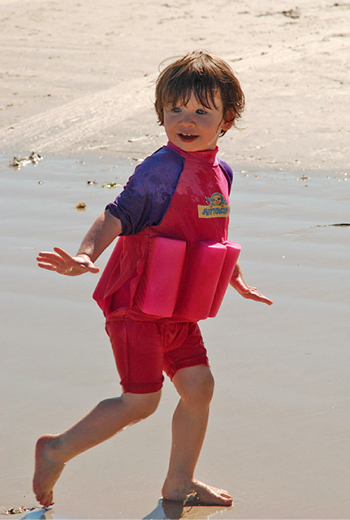
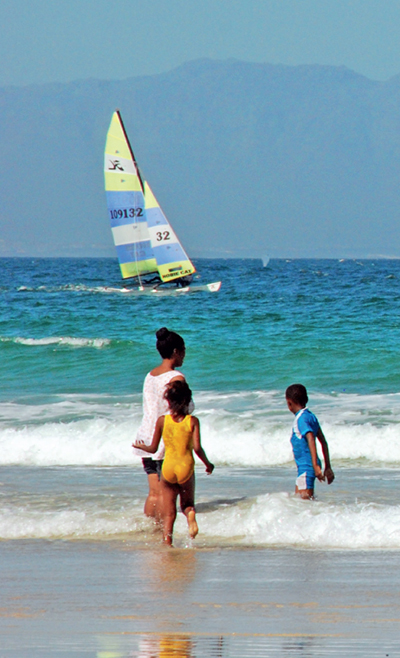
Did you know?
Your best pieces of beach equipment are your eyes and your enquiring mind. It is difficult to keep sea creatures alive in captivity, so rather watch them where they live and leave them there for visiting again.
Put on your sunscreen and come and explore.
Floating animals
After a storm, floating animals wash up on the beach. Look out for bluebottles, by-the-wind sailors, bubble-raft shells and jellyfish.
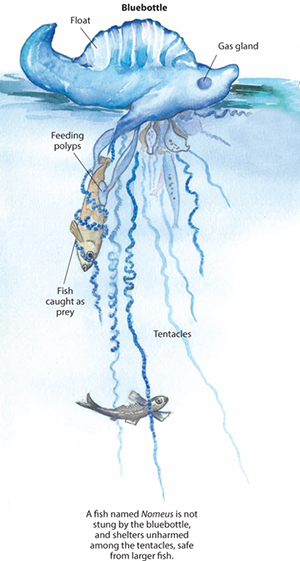
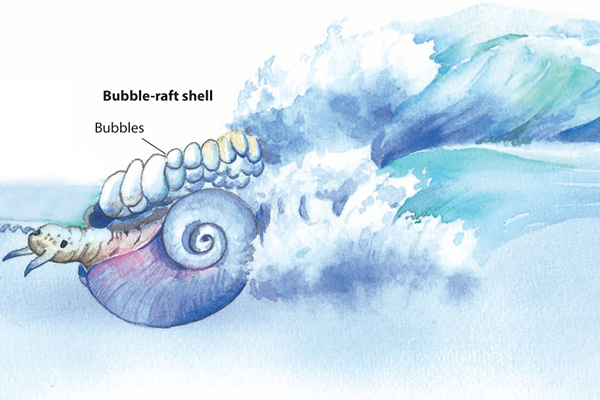
Bluebottles
The bluebottle (sometimes called the Portuguese man-of-war) has a gas-filled balloon that keeps it afloat on the sea. Deadly stinging tentacles trail beneath its float. The stings on these tentacles paralyse and kill the fish on which bluebottles feed. The bluebottle is not a single creature, but a colony of animals called polyps, each with a different use. For example, the tentacle polyps, which may be over 10 metres long, can shorten and coil to carry food up to the feeding polyps.
Unusual food
Imagine eating the stinging tentacles of a bluebottle! Despite the powerful sting, this is what some sea slugs and snails do as they float alongside bluebottles. One sea snail, the bubble-raft shell, makes a raft of bubbles to help it float as it feeds on bluebottles. If you find a bubble-raft shell floating in the water, check whether the raft is carrying any pink egg capsules. Look at the purple dye that it uses to paralyse prey such as by-the-wind sailors and blue buttons.
Things to do
When you see a bluebottle in the water, look for the gland that makes the gas to fill the float. Watch to see how the bluebottle wets its float.
If you are stung by a bluebottle, dont rub the painful area with sand or wash it in fresh water. Instead, remove any pieces of tentacle and wash your skin carefully with salty water. Then soak it in very hot water to relieve the pain. Severe cases are rare but should be treated by a doctor.
Things to do
Collect animals washed up after a storm and float them in a rock pool or clear container filled with sea water. Can you work out why they are blue or colourless?


Rafts to float
The by-the-wind sailor has a delicate air-filled raft with a sail above it, and short stinging tentacles and feeding polyps beneath the raft. The circular floating raft of the blue button, Porpita , lacks a sail but has beautifully branched tentacles. Neither of these creatures has a sting that is harmful to humans.
Jellyfish
Transparent jellyfish are almost invisible either to their enemies or to the tiny creatures on which they feed. They swim by contracting and expanding their umbrella-like bell. In the centre of the bell is the mouth, surrounded by frilly lips. There are four pouches underneath the bell, where the eggs are formed. Most jellyfish are harmless to humans. The box jellyfish, however, has four long tentacles and gives a venomous sting. It is related to a deadly Australian jellyfish, the sea wasp.
Sea swallows use second-hand stings
The sea swallow is not a bird but a beautiful sea slug about 2 centimetres long. It has wing-like flaps that spread out to help it float on the sea. It uses the stings of the bluebottles upon which it feeds in an unusual way. The stinging cells travel through the gut of the sea swallow without causing any damage. They then pass to the surface of the sea slugs skin, where they are used as second-hand stinging weapons.
Next page
